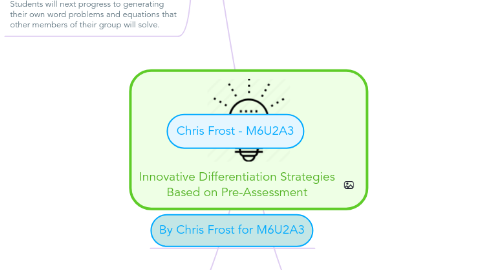Innovative Differentiation Strategies Based on Pre-Assessment
Chris Userにより

1. Chris Frost - M6U2A3
2. By Chris Frost for M6U2A3
3. Innovative Differentiation for Students with an Intermediate Level of Understanding - 12 Students
3.1. Assessments: 1) Kahoot! pre-assessment (link attached) to gauge understanding and determine student groupings and activities. 2) Formative assessments that include whiteboard checks, Khan Academy online practice results, whole-class discussions, exit tickets, and quizzes. Exit tickets and quizzes will be used to determine groupings and activities for subsequent days. 3) The district's required summative assessment at the conclusion of the unit.
3.2. Students will watch a series of Khan Academy videos (link attached) on Chromebooks. These videos will reinforce terminology, as well as walk students through modeling the process of multiplication using repeated addition, groups of, an array, and a number line. Practice problems are available which will be done by students on personal whiteboards or scratch paper. Since there are 12 students in this group, they will work in pairs.
3.3. Students will progress to completing the "Problem of the Week." This is a word problem which requires students to underline key information and solve the problem by using repeated addition, groups of, an array, and a number line. Additionally, students must create an equation using one of the multiplication models they completed. They will work collaboratively to solve the "Problem of the Week."
3.4. Students will next progress to generating their own word problems and equations that other members of their group will solve.
4. Innovative Differentiation for Students with a Low Level of Understanding - 5 Students
4.1. Assessments: 1) Kahoot! pre-assessment (link attached) to gauge understanding and determine student groupings and activities. 2) Formative assessments that include whiteboard checks, Khan Academy online practice results, whole-class discussions, exit tickets, and quizzes. Exit tickets and quizzes will be used to determine groupings and activities for subsequent days. 3) The district's required summative assessment at the conclusion of the unit.
4.2. Students will review flash cards that contain important terminology, like factor and product. They will also review flash cards that show pictures of different multiplication models, like repeated addition, arrays, a number line, and groups of, so they become familiar with how the different models look.
4.3. Students will use math manipulatives, like counting cubes, to build arrays and make groups of to solve multiplication problems.
4.4. Multiplication problems given to this group will include factors that are less than or equal to 5.
4.5. Students will watch a Khan Academy video (link attached) on Chromebooks. The video introduces multiplication and provides problems for students to complete, which they will do on personal whiteboards or scratch paper. On subsequent days, they will progress through more Khan Academy videos and practice problems to become more comfortable and confident.
4.6. Students in this group will be given pre-lessons on what will be taught the following day. They will be asked to share or demonstrate to the class, which will help build trust and confidence.
5. Innovative Differentiation for Students with a High Level of Understanding - 5 Students
5.1. Assessments: 1) Kahoot! pre-assessment (link attached) to gauge understanding and determine student groupings and activities. 2) Formative assessments that include whiteboard checks, Khan Academy online practice results, whole-class discussions, exit tickets, and quizzes. Exit tickets and quizzes will be used to determine groupings and activities for subsequent days. 3) The district's required summative assessment at the conclusion of the unit.
5.2. Students will be given the "Problem of the Week" to solve. This is a word problem which requires the student to underline key information and solve the problem by using repeated addition, groups of, an array, and a number line. Additionally, students must create an equation using one of the multiplication models they completed. They will work collaboratively to solve the "Problem of the Week."
5.3. Students will be given the opportunity to generate their own word problems and equations and have the rest of the class solve them.
5.4. Students will be given the opportunity to engage in peer tutoring to help struggling students gain understanding and confidence.
5.5. When ready, students will be introduced to the idea of division and how it relates to multiplication. They will view Khan Academy videos (link attached) on Chromebooks and complete practice problems.


